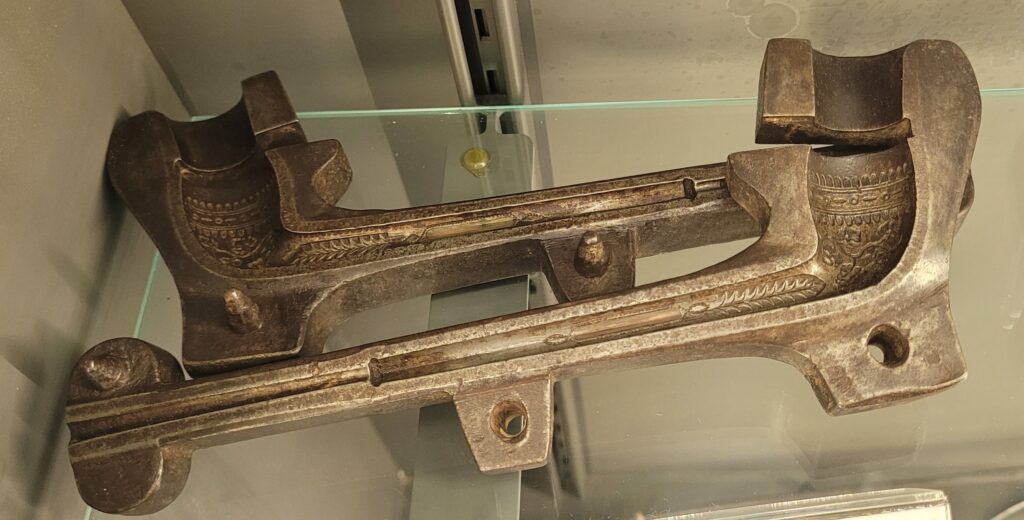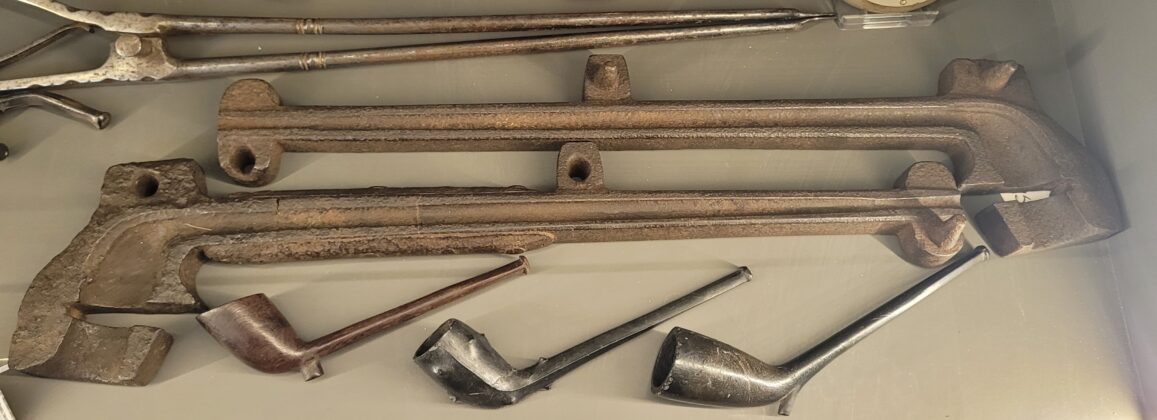The latest in the series on objects from Rye Castle Museum and what they tell us about the history of Rye and the surrounding area.
The collection of clay pipes and pipe making tools
The latest museum object in this series is a clay pipe with decoration of a foot kicking a ball, part of a selection of other decorated pipes and metal pipe making moulds, that can be seen in East Street. The museum has a large collection of complete clay pipes and fragments, many found in 1917 in the cellar of Bannisters Ironmongers on the corner of Cinque Ports Street and Ferry Road. Pipes were made in such large quantities and were often discarded after use, so many clay pipes survive, though often not intact due to their fragility. Clay pipes have been found all around Rye especially around back doors. A large number of broken pipes have been found on Hilders Cliff suggesting that this was the site of a pipe maker.
Tobacco was first bought to England from the Americas in Tudor times and smoked in clay pipes thought to be based on the pipes used by North American Native Americans. As tobacco smoking became more popular, so the making of clay pipes, originally likely to have been begun in London around 1580-1585, spread across the country. The clay pipe industry flourished and peaked around 1700 so that nearly every town and city and many villages had pipe makers. Tax records of 1663 list that living in Mermaid Street were six gentlemen / jurats, a baker, a haberdasher, a widow of a cordwainer (a shoemaker), a fellmonger (a dealer in hides and skins particularly sheepskins), and a wealthy mariner, and two pipe making brothers.
To make a clay pipe, clay was rolled out and a wire inserted into the stem. This was then put into a two-part mould and a stopper used to create the bowl. After being pressed, the pipe was taken out of the mould, excess clay removed, and then left to dry. Before firing in a kiln, the final extra clay was chipped from the stem and bowl. A film of making a clay pipe can be seen here.

The designs of clay pipes changed over time and there were also regional variations. Pipes can be dated by looking at the thickness and length of the stem, the size and design of the bowl and the maker’s mark. The bowl of the pipes developed over time: in the 16th century the heel of the bowl was usually flat but by the 18th century there was a spur on the heel and pipes began to be decorated. Tobacco was expensive from when it was introduced to the mid-16th century so the pipe bowls were small but as tobacco became cheaper, the bowls grew bigger.

As bowls became larger and more highly decorated with complicated designs such as portraits, sports scenes, plants, animals, Royal events, military scenes or scenes showing things such as the Great Exhibition of 1851, so more hand-finishing and slip-casting was used. The makers would mark the stems or the spurs with their names or initials. In the 1800s pubs and taverns often made pipes with their names or images to identify them, an early form of advertising. These pipes were often sold with the beer or ale, included in the price.
The industry went into decline around 1720 due to wars with American and Europe, and due to the increase in the use of snuff, especially amongst the wealthy. In the 19th century pipe smoking once again became fashionable, in part due to the growth of industrial cities. The industry flourished both as a cottage industry, involving families with apprentices, and in larger factories.
Rye had several pipe makers recorded in 18th century Inland Revenue Apprenticeship books: John Walker, had an apprentice, John Inkpen in 1794 and another apprentice, Edward Fidler, worked with pipe maker Thomas Whorwell in 1772. In 1798, a John Walker was recorded as working as pipe maker and a William Walker, possibly his son, was in 1841 making pipes in Wish Street.
Rye had a number of clay pipe makers in the 19th century. Parish, census, and other records, show that several generations of the Apps family lived and worked at Pipemakers Yard in Wish Street, the site of the present-day pub, the Pipemakers Arms. William Apps I was the first of the Apps to make pipes there and in 1851 he was 86 and retired. His son, William Apps II worked between 1839 and 1851 and employed four men. Sixteen-year-old Thomas Dale of Atkins Row, (which was along Military Road, between Cliff Cottages, and almshouses demolished to build the North Salts houses), Samuel King (aged 21) and Thomas Wait (aged 17) were, in 1851 recorded as journeymen for William Apps II. His son William Apps III went on, in 1848, to have a shop in the Landgate and later on the High Street. Henry Apps, another of William’s sons, was recorded as working in Pipemakers Yard in 1851 aged 21.

The Apps family evidently made a comfortable living. In January 1835 the Rye Corporation granted William Apps (possibly the first William) a 99-year lease on a piece of empty land outside the Landgate and for the tenements that he had built on it. In October 1848, Apps assigned the property to George Dan of Rye, a victualler who then passed it on to James Batcheler of Rye, a brewer, in 1856. Batcheler died in August 1874 leaving it to his widow Sarah and nephew, John Bowen. By 1900 the site was known as the Bedford Arms which survives until this day (although presently closed). Robert Lancaster (aged 29) was recorded as living in Bedford Place in 1851. His initials R/L are found on his pipes.

Amongst the clay pipes on display in East Street is an example of one of very few complete Buffalo pipes decorated with buffalo horns and the letters RAOB. This was made for the Royal Antediluvian Order of Buffaloes (RAOB), a fraternal society, similar to a Masonic lodge, founded in 1822. The order worked to raise money for the care of the sick and homeless. According to records of 1848, clay pipes were used in initiation ceremonies and were broken over the members heads, so whole pipes are rare.

Another pipe in the collection is one with a highly decorated bowl in the shape of a bearded and turbaned man. This is known as a Jacob’s head pipe and most have the inscription “I am the real Jacob” written in French around the top of the head. Many were made in France, Germany, Belgium, Holland and England, from 1850-1930s and was one of the most popular head pipes as the colours stood out as the pipe was discoloured over time.
The industry continued into the early 20th century but by the 1930s was once again in decline due to the growth of the cigarette industry, changes in society and two world wars. Clay pipes are still regularly found and those embellished with scenes have become useful sources of social history.
Museum opening hours
The Rye Castle Museum has two sites, one in a former bottling factory in East Street and the other at the Castle / Ypres Tower.
Castle / Ypres Tower is open daily throughout the year. March 30 to October 31 from 10:30am to 5pm. November 1 to March 29 from 10:30am to 3:30pm.
East Street is open at weekends from April to October from 10:30am to 4:30pm (subject to availability of volunteers).
Image Credits: Rye Castle Museum/ Juliet Duff , Rye Castle Museum/Juliet Duff , Juliet Duff , Rye Castle Museum//Juliet Duff .








Fascinating, as ever, Juliet! I can testify to the Hilder’s Cliff reference. You couldn’t put a spade in the ground in our old garden without pieces of pipe turning up!